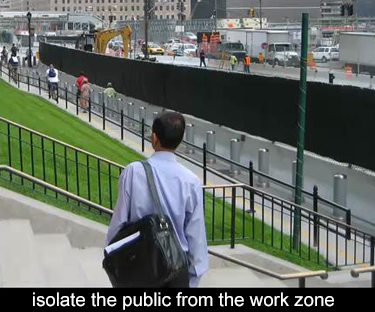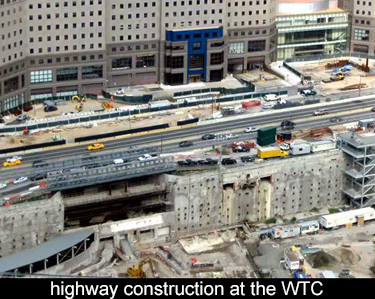Welcome to Class 9. In this class and the next class, we're going to talk about the challenge of building a highway in a dense downtown area. The project we're going to be looking at is West Street or the West Side Highway, as it passes along the World Trade Center site. You could not find a busier or more highly visible site.
While the challenges here were great. There was also some opportunity to get started. There was sufficient space so that you could almost immediately step in and begin your new construction.
For orientation, these are three northbound lanes and three southbound lanes. Alongside of them, as I say, fortunately, there was a good deal of available space. Had it been wide enough, you could have built a new highway in that new space and that would have solved a tremendous number of headaches, but no one is ever that lucky. There was enough space here to build three new lanes and you would be able to shift one of the directions of traffic into that new space. That was the approach to this job. You build three lanes at a time and constantly shift traffic back and forth until you can construct the entire new facility.
There were added challenges. There was the presence of all of the activities associated with the rebuilding at the World Trade Center. Most particularly, there was an underground concourse, which was going to be built joining the World Trade Center site to the existing Financial Center. That underground concourse roughly occupied this space. It needed to pass below West Street.
Obviously, you could not build it until you shifted the traffic back and forth. I'll show you how that work was accomplished. In addition to handling the normal issues of maintaining traffic in both directions, there was the further challenge of shifting traffic to accommodate the structure to be built below West Street.

You can see, from the pedestrian’s point of view, he or she could not see the construction activities. Of course, you could hear them, but I must say, there is so much ambient noise in this area that I'm not sure you could even tell there was construction going on. The goal is to keep the public separated from the construction and to maintain their movements without any interference at all. That was accomplished by dividing the work into many, many phases, always keeping the public concerns in the forefront, and always making sure they had no interference to their movement.
 This is the newly created work zone. Standing inside the work zone, you don't see the public. That, of course, is the goal, to create a real separation between construction activities and the public activities. In this area, construction is just getting started. Some existing pavement is being broken on the right side. That's going to be removed to make way for the new pavement. The area is being prepared for the installation of a new sewer.
This is the newly created work zone. Standing inside the work zone, you don't see the public. That, of course, is the goal, to create a real separation between construction activities and the public activities. In this area, construction is just getting started. Some existing pavement is being broken on the right side. That's going to be removed to make way for the new pavement. The area is being prepared for the installation of a new sewer.
If it was just a matter of shifting traffic back and forth to construct a new roadway, that would be very straightforward and fairly simple. In this project, and probably in your project, the utilities have to be accommodated first. They always present a challenge. In this project, the new highway was going to be built at a higher elevation than the existing and that created a whole new set of issues. The work is not straightforward at all. It's quite complex and requires very careful planning and execution.